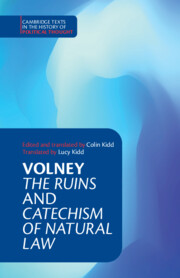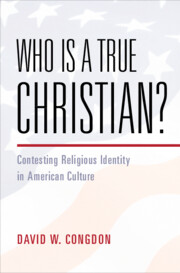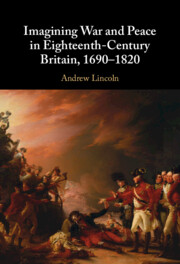245 results
Chapter 4 - Oratory in the French Revolution
-
- Book:
- Democracy, Theatre and Performance
- Published online:
- 17 May 2024
- Print publication:
- 27 June 2024, pp 90-116
-
- Chapter
- Export citation
Chapter 8 - The Enlightenment
- from Part II - Pan-European Moods and Movements
-
-
- Book:
- Europe in British Literature and Culture
- Print publication:
- 13 June 2024, pp 133-148
-
- Chapter
- Export citation
Chapter 14 - Romanticism
- from Part II - Literature
-
-
- Book:
- Goethe in Context
- Published online:
- 16 May 2024
- Print publication:
- 23 May 2024, pp 130-138
-
- Chapter
- Export citation
Chapter 4 - The New Soviet Domestic Worker
- from Part I Introduction
-
- Book:
- Domestic Service in the Soviet Union
- Published online:
- 25 April 2024
- Print publication:
- 02 May 2024, pp 115-144
-
- Chapter
- Export citation
Chapter 1 - Reading Ancient Israelite Prophetic Books
-
- Book:
- The Theology of the Books of Nahum, Habakkuk, and Zephaniah
- Published online:
- 28 March 2024
- Print publication:
- 04 April 2024, pp 1-23
-
- Chapter
- Export citation
Enlightened and Counter-Revolutionary: Revisiting the Origins of Galician Ruthenian Nation-Building
-
- Journal:
- Austrian History Yearbook , First View
- Published online by Cambridge University Press:
- 25 March 2024, pp. 1-27
-
- Article
- Export citation

Volney: ‘The Ruins' and ‘Catechism of Natural Law'
-
- Published online:
- 08 February 2024
- Print publication:
- 15 February 2024
Chapter 2 - Racializing Irish Historical Consciousness
-
-
- Book:
- Race in Irish Literature and Culture
- Published online:
- 04 January 2024
- Print publication:
- 18 January 2024, pp 42-58
-
- Chapter
- Export citation

Who Is a True Christian?
- Contesting Religious Identity in American Culture
-
- Published online:
- 04 January 2024
- Print publication:
- 22 February 2024
Introduction
-
- Book:
- The Poetics of Prophecy
- Published online:
- 14 December 2023
- Print publication:
- 21 December 2023, pp 1-26
-
- Chapter
- Export citation
Kant on Free Speech: Criticism, Enlightenment, and the Exercise of Judgement in the Public Sphere
-
- Journal:
- Kantian Review / Volume 29 / Issue 1 / March 2024
- Published online by Cambridge University Press:
- 15 December 2023, pp. 61-80
- Print publication:
- March 2024
-
- Article
-
- You have access
- Open access
- HTML
- Export citation
5 - Consenting to International Law in Five Moves
- from Part I - Notions and Roles of Consent
-
-
- Book:
- Consenting to International Law
- Published online:
- 23 November 2023
- Print publication:
- 07 December 2023, pp 117-134
-
- Chapter
- Export citation
2 - The Quest for Enlightenment
-
- Book:
- The Buddha
- Published online:
- 09 November 2023
- Print publication:
- 30 November 2023, pp 44-93
-
- Chapter
- Export citation
Conclusion
-
- Book:
- A Colonial Book Market
- Published online:
- 16 November 2023
- Print publication:
- 30 November 2023, pp 276-288
-
- Chapter
- Export citation
Chapter 6 - War and the ‘Science of Man’
- from Part II - Developing Questions
-
- Book:
- Imagining War and Peace in Eighteenth-Century Britain, 1690–1820
- Published online:
- 10 January 2024
- Print publication:
- 23 November 2023, pp 157-182
-
- Chapter
- Export citation

Imagining War and Peace in Eighteenth-Century Britain, 1690–1820
-
- Published online:
- 10 January 2024
- Print publication:
- 23 November 2023
20 - Poland–Lithuania in the Age of Atlantic Revolutions: Dilemmas of Liberty
- from Part II - Western, Central, and Eastern Europe
-
-
- Book:
- The Cambridge History of the Age of Atlantic Revolutions
- Published online:
- 18 October 2023
- Print publication:
- 09 November 2023, pp 514-539
-
- Chapter
- Export citation
4 - The Habsburg Monarchy
- from Part I - Imperial and Postcolonial Settings
-
-
- Book:
- The Cambridge History of Nationhood and Nationalism
- Published online:
- 08 November 2023
- Print publication:
- 09 November 2023, pp 64-87
-
- Chapter
- Export citation
2 - Enlightenment and the French Revolution
- from Part I - Enlightenment and Culture
-
-
- Book:
- The Cambridge History of the Age of Atlantic Revolutions
- Published online:
- 20 October 2023
- Print publication:
- 09 November 2023, pp 80-105
-
- Chapter
- Export citation
1 - Overview of the French Revolution
- from Part I - France
-
-
- Book:
- The Cambridge History of the Age of Atlantic Revolutions
- Published online:
- 18 October 2023
- Print publication:
- 09 November 2023, pp 53-77
-
- Chapter
- Export citation



